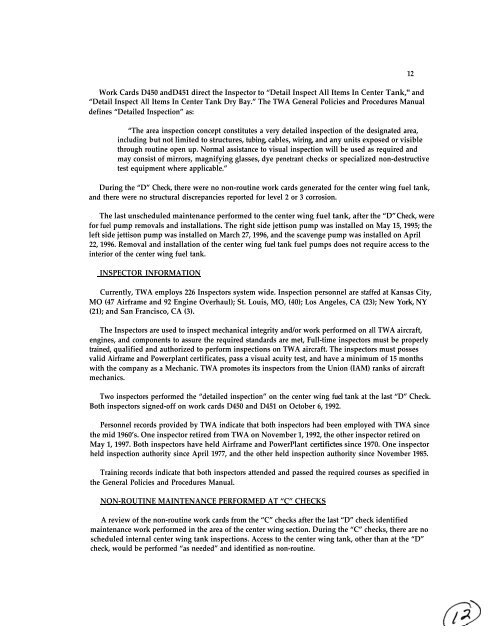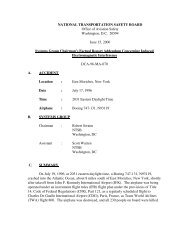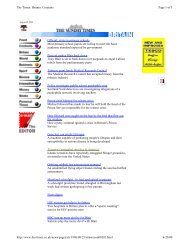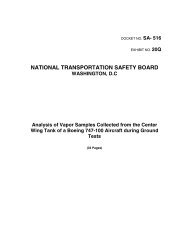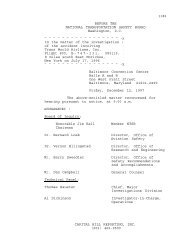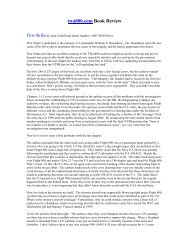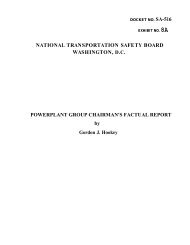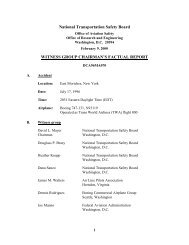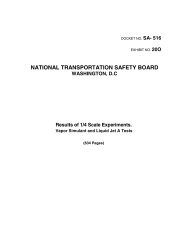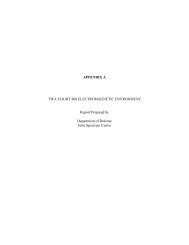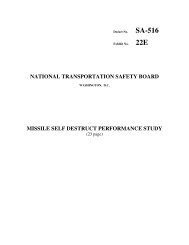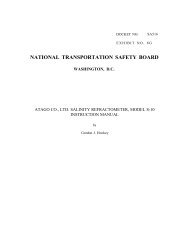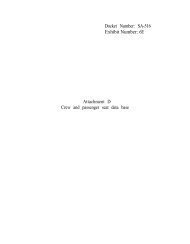Exhibit No. 11A - Group Chairman Factual Report - TWA Flight 800 ...
Exhibit No. 11A - Group Chairman Factual Report - TWA Flight 800 ...
Exhibit No. 11A - Group Chairman Factual Report - TWA Flight 800 ...
You also want an ePaper? Increase the reach of your titles
YUMPU automatically turns print PDFs into web optimized ePapers that Google loves.
Work Cards D450 andD451 direct the Inspector to “Detail Inspect All Items In Center Tank," and“Detail Inspect All Items In Center Tank Dry Bay.” The <strong>TWA</strong> General Policies and Procedures Manualdefines “Detailed Inspection” as:“The area inspection concept constitutes a very detailed inspection of the designated area,including but not limited to structures, tubing, cables, wiring, and any units exposed or visiblethrough routine open up. <strong>No</strong>rmal assistance to visual inspection will be used as required andmay consist of mirrors, magnifying glasses, dye penetrant checks or specialized non-destructivetest equipment where applicable.”During the “D” Check, there were no non-routine work cards generated for the center wing fuel tank,and there were no structural discrepancies reported for level 2 or 3 corrosion.The last unscheduled maintenance performed to the center wing fuel tank, after the “D” Check, werefor fuel pump removals and installations. The right side jettison pump was installed on May 15, 1995; theleft side jettison pump was installed on March 27, 1996, and the scavenge pump was installed on April22, 1996. Removal and installation of the center wing fuel tank fuel pumps does not require access to theinterior of the center wing fuel tank.INSPECTOR INFORMATIONCurrently, <strong>TWA</strong> employs 226 Inspectors system wide. Inspection personnel are staffed at Kansas City,MO (47 Airframe and 92 Engine Overhaul); St. Louis, MO, (40); Los Angeles, CA (23); New York, NY(21); and San Francisco, CA (3).The Inspectors are used to inspect mechanical integrity and/or work performed on all <strong>TWA</strong> aircraft,engines, and components to assure the required standards are met, Full-time inspectors must be properlytrained, qualified and authorized to perform inspections on <strong>TWA</strong> aircraft. The inspectors must possesvalid Airframe and Powerplant certificates, pass a visual acuity test, and have a minimum of 15 monthswith the company as a Mechanic. <strong>TWA</strong> promotes its inspectors from the Union (IAM) ranks of aircraftmechanics.Two inspectors performed the “detailed inspection” on the center wing fuel tank at the last “D” Check.Both inspectors signed-off on work cards D450 and D451 on October 6, 1992.Personnel records provided by <strong>TWA</strong> indicate that both inspectors had been employed with <strong>TWA</strong> sincethe mid 1960’s. One inspector retired from <strong>TWA</strong> on <strong>No</strong>vember 1, 1992, the other inspector retired onMay 1, 1997. Both inspectors have held Airframe and PowerPlant certifictes since 1970. One inspectorheld inspection authority since April 1977, and the other held inspection authority since <strong>No</strong>vember 1985.Training records indicate that both inspectors attended and passed the required courses as specified inthe General Policies and Procedures Manual.NON-ROUTINE MAINTENANCE PERFORMED AT “C” CHECKSA review of the non-routine work cards from the “C” checks after the last “D” check identifiedmaintenance work performed in the area of the center wing section. During the “C” checks, there are noscheduled internal center wing tank inspections. Access to the center wing tank, other than at the “D”check, would be performed “as needed” and identified as non-routine.12


